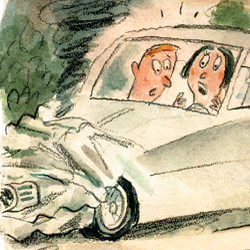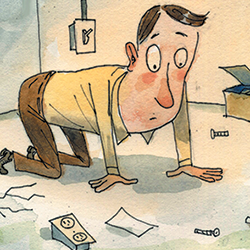|
fixing snafus

illustration: Regan Dunnick
Things Fall Apart
Moving forward without the broken header was never an option, and every delay risked costly overtime charges and the potential of missing the start of the show.
Plan A
Some people enjoy putting together a challenging jigsaw puzzle – searching through the scattered pieces and trying to assemble the image on the box. Of course, it's a lot less fun when the puzzle is a key element of your exhibit and the pieces you pull out of the box are broken beyond repair, which is exactly the situation I was in at a recent show in Denver. As an installation-and-dismantle supervisor for The Trade Group Inc., I was tasked with setting up a client's 50-by-60-foot exhibit at the Custom Electronic Design and Installation Association (CEDIA) Expo. The exhibit featured three 20-foot-tall fabric walls that stood on the ground and were supported by rigging from the ceiling. A series of four elaborate signs with a network of accent lighting was to be suspended above the exhibit, adding a critical storytelling component and illumination of the company's products. The show opened on Thursday, and our build began the Saturday before. Because the overhead elements were tethered to the truss grid reinforcing the fabric walls, three of the four signs needed to be assembled and hoisted out of the way before the rest of the booth could be built. My project manager, Ben Greeley, and I installed the first two headers without any issues. As Saturday came to a close, we wanted to start building the third sign, and that's when things started to come undone, quite literally. This header was supposed to be a 50-by-34-by-60-foot custom triangular shape constructed of tension fabric stretched over a skeleton of aluminum rods that had been welded together. We simply had to assemble the long bars on site, affix the graphic, and hoist away. However, as we unloaded the components, we were stunned to discover that several of the welds had been severely fractured. Apparently the rods, which were shipped on skids, had shifted during transport so that several hung over the front of the pallet. Every time a forklift moved the pallet, one of the forks slammed into the rods, which ended up cracking several of the welds. It was a mess that appeared completely unusable. We immediately called over our colleagues in the rigging department, hoping they would tell us our assessment was wrong. But they took one look at our broken rods and shook their heads, saying under no circumstances could the element be hung. Minus that sign showcasing the company's tagline, our client's brand story would be as fractured as those rods. The header also housed some of the key accent lighting, so without it many of the products below would be shrouded in darkness. Worse yet, we couldn't move forward with the rest of the build until that element was rigged, and every delay risked costly overtime charges and the potential of missing the start of the show. We needed a solution lickety-split. Plan B
Since exhibiting without the header wasn't an option, Ben and I began thinking of ways to repair the welds. But because the damage wasn't discovered until late Saturday evening, finding a welder on a Sunday who could do the work that day was going to be as futile as searching for a unicorn at the end of a rainbow. Plus, even if we'd found a welder, he or she would need to furnish a certificate of insurance to work at the venue. (You would assume all practicing welders have their certificates handy, but you'd be wrong.) Without the certificate, the only other repair option would be to truck the component off site, which would effectively halt the setup operation and burn valuable time that we simply did not have. So we jumped on our phones to see about acquiring new custom components, but that solution proved equally elusive. The crew at our home office in Carrollton, TX, couldn't build the needed parts and get them to the show in time. Likewise, no local production house had the bandwidth to complete the work in the necessary time frame. By the end of the night, all our attempts to repair or replace the broken element hit dead ends. On Sunday morning we finally admitted we weren't going to be able to go ahead with the original construction, so we shifted our thinking from repair to redesign. We cleared the rubble and turned our attention to the unbroken sections. Unfortunately, we quickly recognized it was not possible to maintain the sign's triangular shape with what we had, and given the embedded lighting, that was going to be an issue. Being good puzzle solvers, we set about creating something new from the usable components. Pretty soon, we had a concept for a narrow, 30-foot-long rectangular sign. And with the altered design rigged at just the right angle, we'd then be able to incorporate the lighting needed to illuminate the products below. Confident we could pull off the new plan, we found our riggers and dragged them back to our exhibit to get the go-ahead. They agreed the pieces were structurally sound and could be used, and just like that, we were back in the game – sort of. Our solution, of course, created new problems. First, the existing fabric graphic would not work with the shape of the new header, which led to the second snafu. Waiting for a new graphic meant critical delays in constructing the rest of the exhibit, making it more than likely we wouldn't be done before the show opened. In short, we needed a way to continue assembling the exhibit while we worked on piecing together the new design. Fortunately, because of the sign's new shape, we could raise the motors out of the way, continue work on the rest of the exhibit, and hang the component later. Once we put that plan into action, we reached out to our graphic department with specifications for the new visuals. The home office said it could whip up the new graphics on Monday and overnight them to us. While we waited, the rest of setup moved forward. On Tuesday morning, Ben and I hustled to the show floor and found our new graphics waiting. We sprang into action assembling the header components. Once done, we attached the graphics to the frame and hoisted the sign over the exhibit by sundown. All of Wednesday, everyone worked feverishly to move in products, arrange furniture, and put the finishing touches on the accessories. By the end of the day, the client's brand story was complete, the accent lighting provided the essential wow factor, and everyone was thrilled with how well the new header conformed to the existing design. It was by far one of the most stressful situations I've encountered at a show, but it felt great to piece together a solution that met our high standards, satisfied the customer, and completed the display. — Robert Lassiter, installation and dismantle supervisor, The Trade Group Inc., Carrollton, TX
TELL US A STORY
Send your Plan B exhibiting experiences to Linda Armstrong, larmstrong@exhibitormagazine.com.
|
|
|
||||||||||||||||||||||||||||
|
|
||||||||||||||||||||||||||||
|
TOPICS Measurement & Budgeting Planning & Execution Marketing & Promotion Events & Venues Personal & Career Exhibits & Experiences International Exhibiting Resources for Rookies Research & Resources |
MAGAZINE Subscribe Today! Renew Subscription Update Address Digital Downloads Newsletters Advertise |
FIND-IT Exhibit & Display Producers Products & Services Supplier to Supplier All Companies Compare Get Listed |
EXHIBITORLIVE Sessions Certification Exhibit Hall Exhibit at the Show Registration |
ETRAK Sessions Certification F.A.Q. Registration |
EDUCATION WEEK Overview Sessions Hotel Registration |
CERTIFICATION The Program Steps to Certification Faculty and Staff Enroll in CTSM Submit Quiz Answers My CTSM |
AWARDS Sizzle Awards Exhibit Design Awards Portable/Modular Awards Corporate Event Awards Centers of Excellence |
NEWS Associations/Press Awards Company News International New Products People Shows & Events Venues & Destinations EXHIBITOR News |
||||||||||||||||||||
|
||||||||||||||||||||||||||||






